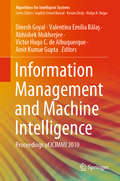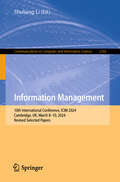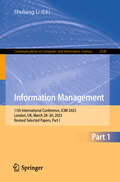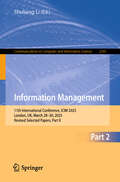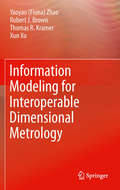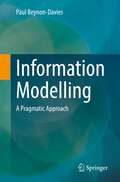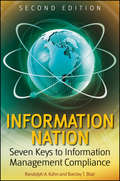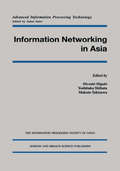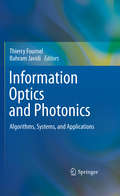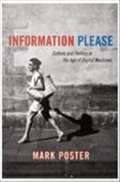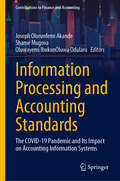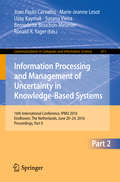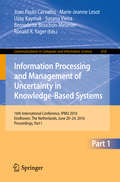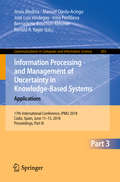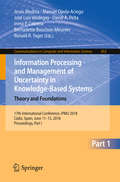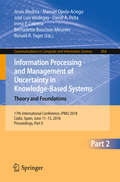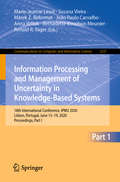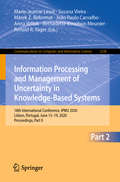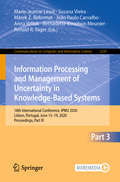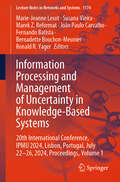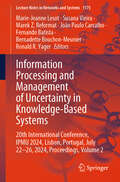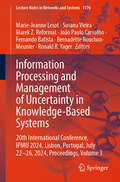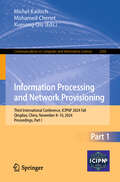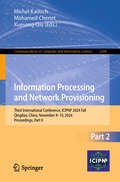- Table View
- List View
Information Management and Machine Intelligence: Proceedings of ICIMMI 2019 (Algorithms for Intelligent Systems)
by Abhishek Mukherjee Amit Kumar Gupta Dinesh Goyal Valentina Emilia Bălaş Victor Hugo C. de AlbuquerqueThis book features selected papers presented at the International Conference on Information Management and Machine Intelligence (ICIMMI 2019), held at the Poornima Institute of Engineering & Technology, Jaipur, Rajasthan, India, on December 14–15, 2019. It covers a range of topics, including data analytics; AI; machine and deep learning; information management, security, processing techniques and interpretation; applications of artificial intelligence in soft computing and pattern recognition; cloud-based applications for machine learning; application of IoT in power distribution systems; as well as wireless sensor networks and adaptive wireless communication.
Information Management: 10th International Conference, ICIM 2024, Cambridge, UK, March 8–10, 2024, Revised Selected Papers (Communications in Computer and Information Science #2102)
by Shuliang LiThis book constitutes the refereed proceedings of the 10th International Conference on Information Management, ICIM 2024, held in Cambridge, UK, during March 8–10, 2024. The 26 full papers and 12 short papers included in this book were carefully reviewed and selected from 139 submissions. They were organized in topical sections as follows: data based information systems and security management, design and development of digital information platform based on AI, knowledge based technological innovation and management, data oriented recommendation system and information management, process optimization and management in modern integrated information systems, intelligent information system and platform construction.
Information Management: 11th International Conference, ICIM 2025, London, UK, March 28–30, 2025, Revised Selected Papers, Part I (Communications in Computer and Information Science #2540)
by Shuliang LiThis two-part volume constitutes the refereed proceedings of the 11th International Conference on Information Management, ICIM 2025, held in London, UK, during March 28–30, 2025. The 53 full papers and 8 short papers presented in these volumes were carefully reviewed and selected from 165 submissions. They were categorized under the topical sections as follows: Part 1: Data-driven intelligent decision-making system and optimization design; Modern integrated information system design and intelligent platform construction based on microservice architecture; Network and information security management; Language model and multimodal language analysis; Machine learning and system modelling. Part 2 : Intelligent Data Analysis Model and Calculation Method in E-commerce; Information management and data analysis in digital manufacturing systems; Big Data Analysis and Risk Management Models in Digital Financial Systems;Data Analysis and Intelligent Technology in Modern Information Management
Information Management: 11th International Conference, ICIM 2025, London, UK, March 28–30, 2025, Revised Selected Papers, Part II (Communications in Computer and Information Science #2541)
by Shuliang LiThis two-part volume constitutes the refereed proceedings of the 11th International Conference on Information Management, ICIM 2025, held in London, UK, during March 28–30, 2025. The 53 full papers and 8 short papers presented in these volumes were carefully reviewed and selected from 165 submissions. They were categorized under the topical sections as follows: Part 1: Data-driven intelligent decision-making system and optimization design; Modern integrated information system design and intelligent platform construction based on microservice architecture; Network and information security management; Language model and multimodal language analysis; Machine learning and system modelling. Part 2 : Intelligent Data Analysis Model and Calculation Method in E-commerce; Information management and data analysis in digital manufacturing systems; Big Data Analysis and Risk Management Models in Digital Financial Systems;Data Analysis and Intelligent Technology in Modern Information Management
Information Modeling for Interoperable Dimensional Metrology
by Robert Brown Y Zhao T Kramer Xun XuDimensional metrology is an essential part of modern manufacturing technologies, but the basic theories and measurement methods are no longer sufficient for today's digitized systems. The information exchange between the software components of a dimensional metrology system not only costs a great deal of money, but also causes the entire system to lose data integrity. Information Modeling for Interoperable Dimensional Metrology analyzes interoperability issues in dimensional metrology systems and describes information modeling techniques. It discusses new approaches and data models for solving interoperability problems, as well as introducing process activities, existing and emerging data models, and the key technologies of dimensional metrology systems. Written for researchers in industry and academia, as well as advanced undergraduate and postgraduate students, this book gives both an overview and an in-depth understanding of complete dimensional metrology systems. By covering in detail the theory and main content, techniques, and methods used in dimensional metrology systems, Information Modeling for Interoperable Dimensional Metrology enables readers to solve real-world dimensional measurement problems in modern dimensional metrology practices.
Information Modelling: A Pragmatic Approach
by Paul Beynon-DaviesThis textbook provides solid guidance on how to produce information models in practice. Information modeling has become increasingly relevant as an approach for understanding the active role that data plays within business and management and promoting the planning of business activities. The text promotes a practical approach to information modelling based around the analysis of communicative practice within delimited domains of organization. The book chapters are designed to be read in sequence. The early chapters build an account of information modelling from the bedrock of a theory of information situations. Later chapters discuss a number of practical issues concerned with the application of this business analysis and design technique. The conclusion demonstrates a larger context for the application and importance of information modelling. Numerous in-text examples of the concepts of information modelling and their application are included throughout the text. A separate chapter is devoted to a range of exercises which the reader can use to test understanding and application of the technique. An appendix with solutions is also provided to support learning. Overall, this textbook provides a step-by-step introduction to information modelling for use in undergraduate and postgraduate modules in information systems, computer science and even digitally focused modules within business and management. No prerequisite knowledge is assumed on the part of the reader. Students and practitioners are tutored in the development of information modelling from first principles. The book covers all the core principles of both entity-relationship diagramming and class diagramming – the two major approaches to information modelling.
Information Nation
by Blair Barclay Kahn RandolphThis fully updated edition demonstrates how businesses can succeed in creating a new culture of information management compliance (IMC) by incorporating an IMC philosophy into a corporate governance structure. Expert advice and insight reveals the proven methodology that adopts the principles, controls, and discipline upon which many corporate compliance programs are built and explains how to apply this methodology to develop and implement IMC programs that anticipate problems and take advantage of opportunities. Plus, you'll learn how to measure information management compliance through the use of auditing and monitoring, following the proper delegation of program roles and components, and creating a culture of information management awareness.
Information Networking in Asia
by Makoto Takizawa Hiroaki Higaki Yoshitaka ShibataThis volume comprises a collection of papers from the 12th international conference on information networking. (ICOIN-12) held in Tokyo 1998. Technical papers on communication networks and distributed systems were presented, along side internet-based electronic commerce network systems, academic research papers, e.g. high-speed communication ATM.
Information Optics and Photonics
by Bahram Javidi Thierry FournelThis book will address the advances, applications, research results, and emerging areas of optics, photonics, computational approaches, nano-photonics, bio-photonics, with applications in information systems. The objectives are to bring together novel approaches, analysis, models, and technologies that enhance sensing, measurement, processing, interpretation, and visualization of information. The book will concentrate on new approaches to information systems, including integration of computational algorithms, bio-inspired models, photonics technologies, information security, bio-photonics, and nano-photonics. Applications include bio-photonics, digitally enhanced sensing and imaging systems, multi-dimensional optical imaging and image processing, bio-inspired imaging, 3D visualization, 3D displays, imaging on nano-scale, quantum optics, super resolution imaging, photonics for biological applications, microscopy, information optics, and holographic information systems.
Information Please
by Mark PosterInformation Please advances the ongoing critical project of the media scholar Mark Poster: theorizing the social and cultural effects of electronically mediated information. In this book Poster conceptualizes a new relation of humans to information machines, a relation that avoids privileging either the human or the machine but instead focuses on the structures of their interactions. Synthesizing a broad range of critical theory, he explores how texts, images, and sounds are made different when they are mediated by information machines, how this difference affects individuals as well as social and political formations, and how it creates opportunities for progressive change. Poster's critique develops through a series of lively studies. Analyzing the appearance of Sesame Street's Bert next to Osama Bin Laden in a New York Times news photo, he examines the political repercussions of this Internet "hoax" as well as the unlimited opportunities that Internet technology presents for the appropriation and alteration of information. He considers the implications of open-source licensing agreements, online personas, the sudden rise of and interest in identity theft, peer-to-peer file sharing, and more. Focusing explicitly on theory, he reflects on the limitations of critical concepts developed before the emergence of new media, particularly globally networked digital communications, and he argues that, contrary to the assertions of Michael Hardt and Antonio Negri, new media do not necessarily reproduce neoimperialisms. Urging a rethinking of assumptions ingrained during the dominance of broadcast media, Poster charts new directions for work on politics and digital culture.
Information Politics, Protests, and Human Rights in the Digital Age
by Mahmood MonshipouriWe live in a highly complex and evolving world that requires a fuller and deeper understanding of how modern technological tools, ideas, practices, and institutions interact, and how different societies adjust themselves to emerging realities of the digital age. This book conveys such issues with a fresh perspective and in a systematic and coherent way. While many studies have explained in depth the change in the aftermath of the unrests and uprisings throughout the world, they rarely mentioned the need for constructing new human rights norms and standards. This edited collection provides a balanced conceptual framework to demonstrate not only the power of autonomous communication networks but also their limits and the increasing setbacks they encounter in different contexts.
Information Processing and Accounting Standards: The COVID-19 Pandemic and Its Impact on Accounting Information Systems (Contributions to Finance and Accounting)
by Shame Mugova Joseph Olorunfemi Akande Oluwayemi IbukunOluwa OdularuThis book addresses challenges caused by COVID-19 crisis on financial reporting and information management systems. Information access, transmission and rapid changes in the operating environment revealed inadequacies of international financial reporting standards. Accounting and information are critical elements for business success. While accounting processes financial information and more often guided by standards, information sciences bothers on having access to the right information. Crisis overtime has exposed the weaknesses and/or limitations of these important ingredients of business. The recent pandemic created different challenges and revealed the inadequacies of several accounting and information systems processes. The dynamics of planned business restructuring activities introduced lots of considerations culminated to additional disclosure for business tax purposes. The volume combines perspectives and research from academics and practitioners from the industry on modifying accounting systems and processes to be resilient in and out of crisis. The chapters in the book highlight recommendations to standards and information system improvement.
Information Processing and Management of Uncertainty in Knowledge-Based Systems
by Ronald R. Yager Uzay Kaymak Joao Paulo Carvalho Marie-Jeanne Lesot Susana Vieira Bernadette Bouchon-MeunierThis two volume set (CCIS 610 and 611) constitute the proceedings of the 16th International Conference on Information processing and Management of Uncertainty in Knowledge-Based Systems, IPMU 2016, held in Eindhoven, The Netherlands, in June 2016. The 127 revised full papers presented together with four invited talks were carefully reviewed and selected from numerous submissions. The papers are organized in topical sections on fuzzy measures and integrals; uncertainty quantification with imprecise probability; textual data processing; belief functions theory and its applications; graphical models; fuzzy implications functions; applications in medicine and bioinformatics; real-world applications; soft computing for image processing; clustering; fuzzy logic, formal concept analysis and rough sets; graded and many-valued modal logics; imperfect databases; multiple criteria decision methods; argumentation and belief revision; databases and information systems; conceptual aspects of data aggregation and complex data fusion; fuzzy sets and fuzzy logic; decision support; comparison measures; machine learning; social data processing; temporal data processing; aggregation.
Information Processing and Management of Uncertainty in Knowledge-Based Systems
by Ronald R. Yager Uzay Kaymak Joao Paulo Carvalho Marie-Jeanne Lesot Susana Vieira Bernadette Bouchon-MeunierThis two volume set (CCIS 610 and 611) constitute the proceedings of the 16th International Conference on Information processing and Management of Uncertainty in Knowledge-Based Systems, IPMU 2016, held in Eindhoven, The Netherlands, in June 2016. The 127 revised full papers presented together with four invited talks were carefully reviewed and selected from numerous submissions. The papers are organized in topical sections on fuzzy measures and integrals; uncertainty quantification with imprecise probability; textual data processing; belief functions theory and its applications; graphical models; fuzzy implications functions; applications in medicine and bioinformatics; real-world applications; soft computing for image processing; clustering; fuzzy logic, formal concept analysis and rough sets; graded and many-valued modal logics; imperfect databases; multiple criteria decision methods; argumentation and belief revision; databases and information systems; conceptual aspects of data aggregation and complex data fusion; fuzzy sets and fuzzy logic; decision support; comparison measures; machine learning; social data processing; temporal data processing; aggregation.
Information Processing and Management of Uncertainty in Knowledge-Based Systems. Applications: 17th International Conference, IPMU 2018, Cádiz, Spain, June 11-15, 2018, Proceedings, Part III (Communications in Computer and Information Science #855)
by Irina Perfilieva Ronald R. Yager Manuel Ojeda-Aciego José Luis Verdegay Bernadette Bouchon-Meunier Jesús MedinaThis three volume set (CCIS 853-855) constitutes the proceedings of the 17th International Conference on Information Processing and Management of Uncertainty in Knowledge-Based Systems, IPMU 2017, held in Cádiz, Spain, in June 2018.The 193 revised full papers were carefully reviewed and selected from 383 submissions. The papers are organized in topical sections on advances on explainable artificial intelligence; aggregation operators, fuzzy metrics and applications; belief function theory and its applications; current techniques to model, process and describe time series; discrete models and computational intelligence; formal concept analysis and uncertainty; fuzzy implication functions; fuzzy logic and artificial intelligence problems; fuzzy mathematical analysis and applications; fuzzy methods in data mining and knowledge discovery; fuzzy transforms: theory and applications to data analysis and image processing; imprecise probabilities: foundations and applications; mathematical fuzzy logic, mathematical morphology; measures of comparison and entropies for fuzzy sets and their extensions; new trends in data aggregation; pre-aggregation functions and generalized forms of monotonicity; rough and fuzzy similarity modelling tools; soft computing for decision making in uncertainty; soft computing in information retrieval and sentiment analysis; tri-partitions and uncertainty; decision making modeling and applications; logical methods in mining knowledge from big data; metaheuristics and machine learning; optimization models for modern analytics; uncertainty in medicine; uncertainty in Video/Image Processing (UVIP).
Information Processing and Management of Uncertainty in Knowledge-Based Systems. Theory and Foundations: 17th International Conference, IPMU 2018, Cádiz, Spain, June 11-15, 2018, Proceedings, Part I (Communications in Computer and Information Science #853)
by Ronald R. Yager Manuel Ojeda-Aciego José Luis Verdegay Bernadette Bouchon-Meunier David A. Pelta Jesús Medina Inma P. CabreraThis three volume set (CCIS 853-855) constitutes the proceedings of the 17th International Conference on Information Processing and Management of Uncertainty in Knowledge-Based Systems, IPMU 2017, held in Cádiz, Spain, in June 2018.The 193 revised full papers were carefully reviewed and selected from 383 submissions. The papers are organized in topical sections on advances on explainable artificial intelligence; aggregation operators, fuzzy metrics and applications; belief function theory and its applications; current techniques to model, process and describe time series; discrete models and computational intelligence; formal concept analysis and uncertainty; fuzzy implication functions; fuzzy logic and artificial intelligence problems; fuzzy mathematical analysis and applications; fuzzy methods in data mining and knowledge discovery; fuzzy transforms: theory and applications to data analysis and image processing; imprecise probabilities: foundations and applications; mathematical fuzzy logic, mathematical morphology; measures of comparison and entropies for fuzzy sets and their extensions; new trends in data aggregation; pre-aggregation functions and generalized forms of monotonicity; rough and fuzzy similarity modelling tools; soft computing for decision making in uncertainty; soft computing in information retrieval and sentiment analysis; tri-partitions and uncertainty; decision making modeling and applications; logical methods in mining knowledge from big data; metaheuristics and machine learning; optimization models for modern analytics; uncertainty in medicine; uncertainty in Video/Image Processing (UVIP).
Information Processing and Management of Uncertainty in Knowledge-Based Systems. Theory and Foundations: 17th International Conference, IPMU 2018, Cádiz, Spain, June 11-15, 2018, Proceedings, Part II (Communications in Computer and Information Science #854)
by Ronald R. Yager Manuel Ojeda-Aciego José Luis Verdegay Bernadette Bouchon-Meunier David A. Pelta Jesús Medina Inma P. CabreraThis three volume set (CCIS 853-855) constitutes the proceedings of the 17th International Conference on Information Processing and Management of Uncertainty in Knowledge-Based Systems, IPMU 2017, held in Cádiz, Spain, in June 2018.The 193 revised full papers were carefully reviewed and selected from 383 submissions. The papers are organized in topical sections on advances on explainable artificial intelligence; aggregation operators, fuzzy metrics and applications; belief function theory and its applications; current techniques to model, process and describe time series; discrete models and computational intelligence; formal concept analysis and uncertainty; fuzzy implication functions; fuzzy logic and artificial intelligence problems; fuzzy mathematical analysis and applications; fuzzy methods in data mining and knowledge discovery; fuzzy transforms: theory and applications to data analysis and image processing; imprecise probabilities: foundations and applications; mathematical fuzzy logic, mathematical morphology; measures of comparison and entropies for fuzzy sets and their extensions; new trends in data aggregation; pre-aggregation functions and generalized forms of monotonicity; rough and fuzzy similarity modelling tools; soft computing for decision making in uncertainty; soft computing in information retrieval and sentiment analysis; tri-partitions and uncertainty; decision making modeling and applications; logical methods in mining knowledge from big data; metaheuristics and machine learning; optimization models for modern analytics; uncertainty in medicine; uncertainty in Video/Image Processing (UVIP).
Information Processing and Management of Uncertainty in Knowledge-Based Systems: 18th International Conference, IPMU 2020, Lisbon, Portugal, June 15–19, 2020, Proceedings, Part I (Communications in Computer and Information Science #1237)
by Ronald R. Yager Marek Z. Reformat Marie-Jeanne Lesot Susana Vieira Bernadette Bouchon-Meunier João Paulo Carvalho Anna WilbikThis three volume set (CCIS 1237-1239) constitutes the proceedings of the 18th International Conference on Information Processing and Management of Uncertainty in Knowledge-Based Systems, IPMU 2020, in June 2020. The conference was scheduled to take place in Lisbon, Portugal, at University of Lisbon, but due to COVID-19 pandemic it was held virtually. The 173 papers were carefully reviewed and selected from 213 submissions. The papers are organized in topical sections: homage to Enrique Ruspini; invited talks; foundations and mathematics; decision making, preferences and votes; optimization and uncertainty; games; real world applications; knowledge processing and creation; machine learning I; machine learning II; XAI; image processing; temporal data processing; text analysis and processing; fuzzy interval analysis; theoretical and applied aspects of imprecise probabilities; similarities in artificial intelligence; belief function theory and its applications; aggregation: theory and practice; aggregation: pre-aggregation functions and other generalizations of monotonicity; aggregation: aggregation of different data structures; fuzzy methods in data mining and knowledge discovery; computational intelligence for logistics and transportation problems; fuzzy implication functions; soft methods in statistics and data analysis; image understanding and explainable AI; fuzzy and generalized quantifier theory; mathematical methods towards dealing with uncertainty in applied sciences; statistical image processing and analysis, with applications in neuroimaging; interval uncertainty; discrete models and computational intelligence; current techniques to model, process and describe time series; mathematical fuzzy logic and graded reasoning models; formal concept analysis, rough sets, general operators and related topics; computational intelligence methods in information modelling, representation and processing.
Information Processing and Management of Uncertainty in Knowledge-Based Systems: 18th International Conference, IPMU 2020, Lisbon, Portugal, June 15–19, 2020, Proceedings, Part II (Communications in Computer and Information Science #1238)
by Ronald R. Yager Marek Z. Reformat Marie-Jeanne Lesot Susana Vieira Bernadette Bouchon-Meunier João Paulo Carvalho Anna WilbikThis three volume set (CCIS 1237-1239) constitutes the proceedings of the 18th International Conference on Information Processing and Management of Uncertainty in Knowledge-Based Systems, IPMU 2020, in June 2020. The conference was scheduled to take place in Lisbon, Portugal, at University of Lisbon, but due to COVID-19 pandemic it was held virtually. The 173 papers were carefully reviewed and selected from 213 submissions. The papers are organized in topical sections: homage to Enrique Ruspini; invited talks; foundations and mathematics; decision making, preferences and votes; optimization and uncertainty; games; real world applications; knowledge processing and creation; machine learning I; machine learning II; XAI; image processing; temporal data processing; text analysis and processing; fuzzy interval analysis; theoretical and applied aspects of imprecise probabilities; similarities in artificial intelligence; belief function theory and its applications; aggregation: theory and practice; aggregation: pre-aggregation functions and other generalizations of monotonicity; aggregation: aggregation of different data structures; fuzzy methods in data mining and knowledge discovery; computational intelligence for logistics and transportation problems; fuzzy implication functions; soft methods in statistics and data analysis; image understanding and explainable AI; fuzzy and generalized quantifier theory; mathematical methods towards dealing with uncertainty in applied sciences; statistical image processing and analysis, with applications in neuroimaging; interval uncertainty; discrete models and computational intelligence; current techniques to model, process and describe time series; mathematical fuzzy logic and graded reasoning models; formal concept analysis, rough sets, general operators and related topics; computational intelligence methods in information modelling, representation and processing.
Information Processing and Management of Uncertainty in Knowledge-Based Systems: 18th International Conference, IPMU 2020, Lisbon, Portugal, June 15–19, 2020, Proceedings, Part III (Communications in Computer and Information Science #1239)
by Ronald R. Yager Marek Z. Reformat Marie-Jeanne Lesot Susana Vieira Bernadette Bouchon-Meunier João Paulo Carvalho Anna WilbikThis three volume set (CCIS 1237-1239) constitutes the proceedings of the 18th International Conference on Information Processing and Management of Uncertainty in Knowledge-Based Systems, IPMU 2020, in June 2020. The conference was scheduled to take place in Lisbon, Portugal, at University of Lisbon, but due to COVID-19 pandemic it was held virtually. The 173 papers were carefully reviewed and selected from 213 submissions. The papers are organized in topical sections: homage to Enrique Ruspini; invited talks; foundations and mathematics; decision making, preferences and votes; optimization and uncertainty; games; real world applications; knowledge processing and creation; machine learning I; machine learning II; XAI; image processing; temporal data processing; text analysis and processing; fuzzy interval analysis; theoretical and applied aspects of imprecise probabilities; similarities in artificial intelligence; belief function theory and its applications; aggregation: theory and practice; aggregation: pre-aggregation functions and other generalizations of monotonicity; aggregation: aggregation of different data structures; fuzzy methods in data mining and knowledge discovery; computational intelligence for logistics and transportation problems; fuzzy implication functions; soft methods in statistics and data analysis; image understanding and explainable AI; fuzzy and generalized quantifier theory; mathematical methods towards dealing with uncertainty in applied sciences; statistical image processing and analysis, with applications in neuroimaging; interval uncertainty; discrete models and computational intelligence; current techniques to model, process and describe time series; mathematical fuzzy logic and graded reasoning models; formal concept analysis, rough sets, general operators and related topics; computational intelligence methods in information modelling, representation and processing.
Information Processing and Management of Uncertainty in Knowledge-Based Systems: 20th International Conference, IPMU 2024, Lisbon, Portugal, July 22-26, 2024, Proceedings, Volume 1 (Lecture Notes in Networks and Systems #1174)
by Ronald R. Yager Marek Z. Reformat Marie-Jeanne Lesot Susana Vieira Bernadette Bouchon-Meunier Fernando Batista João Paulo CarvalhoThis book is a collection of papers focused on techniques for managing uncertainty and aggregation. It provides a forum for exchanging ideas between theoreticians and practitioners in these and related areas. The papers are part of the 20th International Conference on Information Processing and Management of Uncertainty in Knowledge-Based Systems, which will occur in Lisbon, Portugal, from July 22 to 26, 2024. The collection describes the latest findings on topics such as advances in fuzzy systems and data analysis, optimization, scheduling via modeling uncertainty, explainability, decision-making, implications, data aggregation, and aggregation operators. A special chapter is dedicated to the memory of Michio Sugeno. The book is a valuable resource for practitioners, researchers, and graduate students who want to apply fuzzy-based techniques to real-world data analysis and management processes involving imprecision and uncertainty.
Information Processing and Management of Uncertainty in Knowledge-Based Systems: 20th International Conference, IPMU 2024, Lisbon, Portugal, July 22-26, 2024, Proceedings, Volume 2 (Lecture Notes in Networks and Systems #1175)
by Ronald R. Yager Marek Z. Reformat Marie-Jeanne Lesot Susana Vieira Bernadette Bouchon-Meunier Fernando Batista João Paulo CarvalhoThis book is a collection of papers focused on techniques for managing uncertainty and aggregation. It provides a forum for exchanging ideas between theoreticians and practitioners in these and related areas. The papers are part of the 20th International Conference on Information Processing and Management of Uncertainty in Knowledge-Based Systems, which will occur in Lisbon, Portugal, from July 22 to 26, 2024. The collection describes the latest findings on topics such as advances in fuzzy systems and data analysis, optimization, scheduling via modeling uncertainty, explainability, decision-making, implications, data aggregation, and aggregation operators. A special chapter is dedicated to the memory of Michio Sugeno. The book is a valuable resource for practitioners, researchers, and graduate students who want to apply fuzzy-based techniques to real-world data analysis and management processes involving imprecision and uncertainty.
Information Processing and Management of Uncertainty in Knowledge-Based Systems: 20th International Conference, IPMU 2024, Lisbon, Portugal, July 22-26, 2024, Proceedings, Volume 3 (Lecture Notes in Networks and Systems #1176)
by Ronald R. Yager Marek Z. Reformat Marie-Jeanne Lesot Susana Vieira Bernadette Bouchon-Meunier Fernando Batista João Paulo CarvalhoThis book is a collection of papers focused on techniques for managing uncertainty and aggregation. It provides a forum for exchanging ideas between theoreticians and practitioners in these and related areas. The papers are part of the 20th International Conference on Information Processing and Management of Uncertainty in Knowledge-Based Systems, which will occur in Lisbon, Portugal, from July 22 to 26, 2024. The collection describes the latest findings on topics such as advances in fuzzy systems and data analysis, optimization, scheduling via modeling uncertainty, explainability, decision-making, implications, data aggregation, and aggregation operators. A special chapter is dedicated to the memory of Michio Sugeno. The book is a valuable resource for practitioners, researchers, and graduate students who want to apply fuzzy-based techniques to real-world data analysis and management processes involving imprecision and uncertainty.
Information Processing and Network Provisioning: Third International Conference, ICIPNP 2024 Fall, Qingdao, China, November 8–10, 2024, Proceedings, Part I (Communications in Computer and Information Science #2593)
by Xuesong Qiu Michel Kadoch Mohamed CherietThe proceedings set CCIS 2593 until CCIS 2596 constitutes the proceedings of the Third International Conference on Information Processing and Network Provisioning, ICIPNP 2024, which took place in Qingdao, China, during November 8-10, 2024. The 153 full papers presented in the proceedings were carefully reviewed and selected from 277 submissions. They deal with up to date research ranging from information and signal processing and network provisioning to computer communications and network applications.
Information Processing and Network Provisioning: Third International Conference, ICIPNP 2024 Fall, Qingdao, China, November 8–10, 2024, Proceedings, Part II (Communications in Computer and Information Science #2594)
by Xuesong Qiu Michel Kadoch Mohamed CherietThe proceedings set CCIS 2593 until CCIS 2596 constitutes the proceedings of the Third International Conference on Information Processing and Network Provisioning, ICIPNP 2024, which took place in Qingdao, China, during November 8-10, 2024. The 153 full papers presented in the proceedings were carefully reviewed and selected from 277 submissions. They deal with up to date research ranging from information and signal processing and network provisioning to computer communications and network applications.
